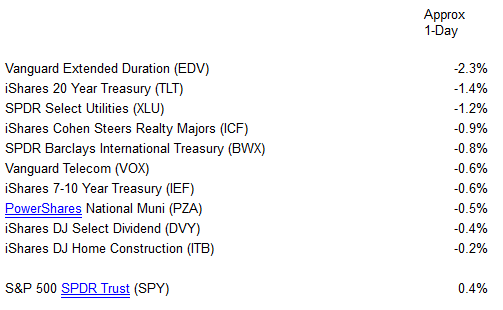How Rising Interest Rates Would Impact Top-Selling Bond ETFs
Investors are getting bombarded by talk of a so-called Great Rotation from fixed-income to stocks after a three-decade bull run in bonds and as interest rates bump higher and U.S. equities flirt with all-time highs.
Of course, investors who bought bond ETFs the last three years are sitting on nice gains following the drop in Treasury yields to historic lows.
ConvergEx Group chief market strategist Nicholas Colas borrows a gambling term to call these bond ETF profits the “House money.”
“But just how vulnerable is that coupon-clipping ‘House money’ to a rise in interest rates? A quick look at some of the most popular fixed income ETFs of the last three years finds that it would take a 200 basis point backup in rates to threaten the risk-loving ‘House money’ which should migrate to stocks in 2013,” he wrote in a note this week.
Over the past three years, mutual fund investors have pumped $931 billion to taxable long-term portfolios, while U.S.-listed fixed-income ETFs have gathered $104 billion, according to ConvergEx.
“To get a sense of the investment returns and duration (interest rate risk) of the most popular bond investments of the last three years, we took the nine ETFs with the largest aggregate money flows over that period (60% of all the money invested in bond ETFs),” Colas wrote.
‘House money’
These ETFs are Vanguard Total Bond Market ETF (BND), iShares iBoxx High Yield Corporate Bond Fund (HYG), iShares iBoxx Investment Grade Corporate Bond Fund (LQD), SPDR Barclays High Yield Bond (JNK), Vanguard Short-term Bond ETF (BSV), iShares JPMorgan USD Emerging Markets Bond (EMB), Vanguard Short-Term Corporate Bond (VCSH), iShares Barclays MBS Bond Fund (MBB) and iShares has the Barclays 1-3 Year Credit Bond Fund (CSJ).
“The average price return over the period was 6%, and the average annual yield is currently 3.4%. Average duration is 4.3 years, with a pretty wide swath of 2-almost 8 years in that mix,” the strategist points out.
“Assuming our mini-sample is representative of the average investment profile for the bond portion of a portfolio, we can take an educated guess as to how much interest rate risk they might be able to bear before their ‘House money’ effect begins to lose its courage,” Colas adds.
He makes a rough estimate that a typical investor is up about 16% over the past three years in their diversified basket of bond investments, and assumes they start to get cautious if they lose half of that over the course of 2013.
“The average duration of 4.3 years means that interest rates would have to move about 200 basis points before our ‘House money’ blessed bond investor got skittish. That basically means a U.S. 10 year Treasury yield of 4%, rather than the current 2% (assume spreads stay pretty constant),” the ConvergEx strategist concludes. “Up until that point, investors may well play the reallocation game (as long as stocks maintain their uptrend). After that, they pull in the horns and probably reduce risk.”
Full disclosure: Tom Lydon’s clients own BSV, EMB, JNK, HYG, LQD.
The opinions and forecasts expressed herein are solely those of John Spence, and may not actually come to pass. Information on this site should not be used or construed as an offer to sell, a solicitation of an offer to buy, or a recommendation for any product.

